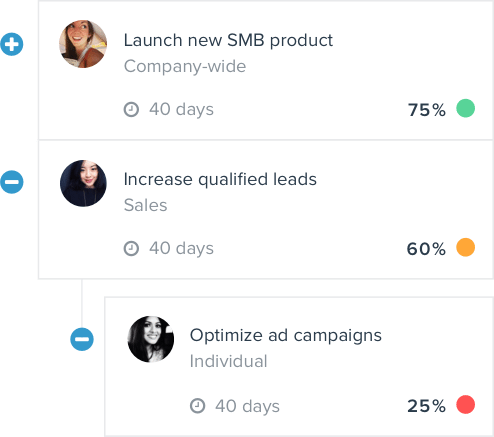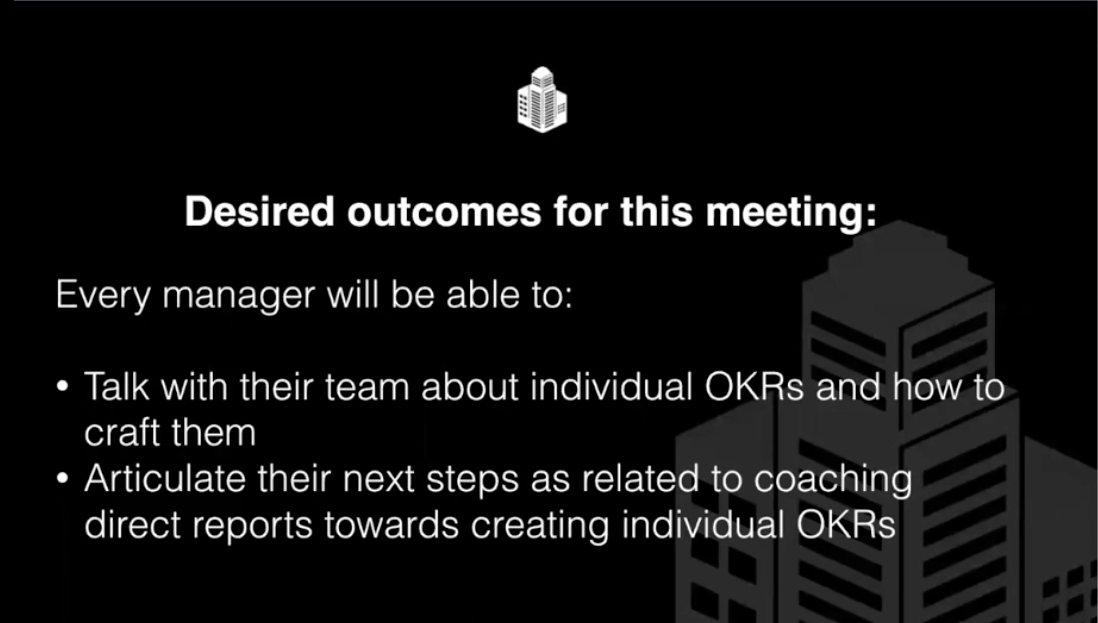Advice On How To Rollout OKR Software To Your Entire Company
By now, you have probably heard of the OKR methodology, or perhaps you already use OKRs to keep people focused and successful at your company.
What are OKRs?
Objectives and Key Results (OKRs) are used by businesses as large as Google, or as small as five person startup teams. These businesses meet periodically (usually quarterly) to set a handful of company-wide objectives. Objectives are then set for each team and individual employee, and are nested so that each employee regularly works on priorities that serve major company initiatives. Many companies have adopted an OKR tracking software or OKR management software to ensure real time success in rolling out this framework.

All management processes come with a learning curve and often have to be adapted to a specific organizational culture and makeup. Seamlessly introducing OKRs to your entire company can be challenging, so we thought we’d help a bit…
I recently hosted a webinar with Annie Mosbacher, Chief of Staff at NationBuilder, who helped roll out OKRs across their entire organization. NationBuilder is a leadership company, best known for their software and for providing educational and cultural infrastructure to help lower the barriers to leadership so that anyone can lead.
Annie facilitates the work of their leadership team to ensure that they achieve their company goals and priorities. She has dedicated her career to building organizations and systems to help people flourish in their work and reach their greatest potential.
SM: What are the events and decisions that led NationBuilder to adopt OKRs as a methodology, and what were you doing beforehand to manage your goals and priorities?
AM: We previously created our own bespoke process to track efforts across the company. We were focused on alignment around tasks and improving communication and input from each team. We used Trello and cobbled together our “commitments process”, which were the commitments that each individual employee and team made to help achieve company goals.
Tracking tasks is important, but this process became a laundry list of all the things that we were doing across the company. The question we then asked was, are we doing the right things to achieve the results that we’re looking for? We were missing a beat on focusing on results and instead focused pretty exclusively on tasks.
So back in November, Jim (our CEO) and Lea (our President) took their first real vacation. They went out to a cabin in the woods for a week and did some big picture thinking. Just as they arrived Jim received an email from 15Five saying, We’re launching Objectives (OKRs)! Everything just came together perfectly to shift our strategic planning and work planning over to the Objectives feature.
SM: We hear about similar challenges from other customers, where the team is focused on tasks and not on results through setting goals. Can you share a bit more about the shift in mindset here?
AM: This mental shift was one of the most difficult parts of adopting Objectives and rolling it out company wide. It helps to separate the process and concept for setting objectives and really focus on the results we wanted. We moved work planning and weekly task management somewhere else.
We started by announcing company-wide OKRs at our annual Winter Summit in December, where we share our “state of the nation”. We then focused on rolling out OKRs at the team level, where each team could understand where they wanted to move a particular needle.
We then rolled key objectives out on the individual level where the biggest disconnect between task orientation and results focus occurs. Each employee started with their measurable key results and then considered the tasks that they would need to perform to achieve them.
SM: What was your process for becoming an in-house expert in Objectives and Key Results?
AM: I really appreciate all of the resources that 15Five shared, including blogs. I followed the trail of experts you quoted back to LinkedIn and then discovered their resources as well.
What I learned really quickly is that there are many contradictions out there in the way that people approach OKRs. I took all of that information, synthesized it through the lens of how our company tends to work best, and then shared those resources with others.
SM: What were some of the coaching and development efforts that you took to educate the rest of the company?
AM: (Amy shares her screen here at Chapter 5, 8:09 to walk through a training presentation that she sent out to company leaders who manage direct reports.) This training was not only focused on setting really strong team level objectives and key results but also to ensure that all managers had the resources they needed to coach direct reports on setting individual objectives. There is a distinct difference in how you want to set a team objective versus one at the individual level.

One of the major things that I touched on was the why behind OKRs. The three reasons were transparency, alignment, and following a bottom-up and top-down approach to setting work objectives.
We believe in having transparency around business decisions and setting people up to contribute to those decisions. Alignment means that everyone knows exactly what they are working on every day and how that aligns with business priorities. This ensures that nobody is floundering or feels like they are working on something in vain.
We also have a whole set of values around speaking our minds, especially around problem solving. This is part of the bottom-up/top-down approach. OKR tools really help create that two-way street of setting up priorities in a company.
Another main focus of the training was how to craft an objective. Managers can start by asking these two questions:
– What do you hope to accomplish?
– What are some of the team-level key results you can move?
Additionally, people should create objectives that are clear and personally significant. OKRs are not another thing you have to do, they are a tool to help drive your work. They should get you excited to get out of bed in the morning.
OKRs should be aligned with what’s most important to the team and company in the moment, and should be realistic. Stretch goals are helpful, but employees should always end the quarter with a feeling of accomplishment.
We also warned managers about the likely challenges and how to go into coaching conversations with direct reports knowing that those employees are task oriented (not results oriented). There may also be difficulty in identifying the team key results that can most influence outcomes.
Rolling out OKRs at your organization won’t be a breeze, but it’s also not rocket science. With the myriad resources (like this webinar) available, you can become an OKR expert in no time. Watch the rest of the video for Annie’s answers to these questions:
1) What are some of your guidelines around OKRs? How do you prevent people from overcommitting?
2) What are some examples of personal OKRs
3) How has implementing OKRs impacted the CEO?
4) In what ways did 15Five help you rollout OKRs to the organization?
5) In what ways are you changing your OKR process from when you first implemented them?
Want to learn more about how 15Five’s OKR tools can help you drive success at your organization? Schedule a demo today.
More about NationBuilder:
NationBuilder is a leadership company best known for their software and for providing educational and cultural infrastructure to help lower the barriers to leadership so that anyone can lead. They currently serve over 7,000 customers in 112 companies, across political, non-profit and advocacy sectors. In the 2016 US presidential election, three of the four major candidates ran their campaigns on NationBuilder. To date, NationBuilder customers have raised over $1.3 Billion in total donations.
Shane Metcalf is Co-founder and VP of Customer Success at 15Five, a lightweight weekly check-in that delivers a full suite of integrated tools – including continuous employee feedback, Objectives (OKRs), pulse surveys, peer recognition, and one-on-one meeting agendas. Shane’s background as an executive coach focused on building high performing teams and thriving companies earned him the additional title, “Unofficial VP of People & Culture”.




